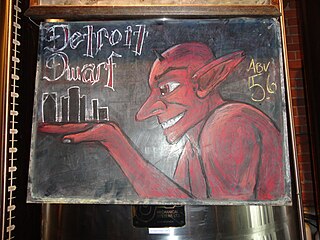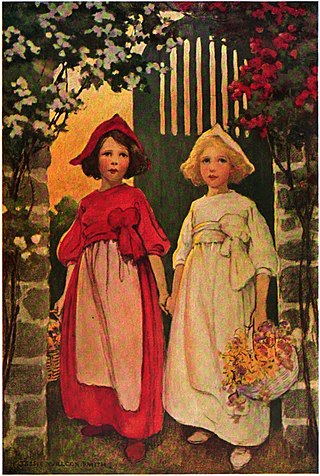Related Research Articles

Faust is the protagonist of a classic German legend based on the historical Johann Georg Faust. The erudite Faust is highly successful yet dissatisfied with his life, which leads him to make a pact with the Devil at a crossroads, exchanging his soul for unlimited knowledge and worldly pleasures. The Faust legend has been the basis for many literary, artistic, cinematic, and musical works that have reinterpreted it through the ages. "Faust" and the adjective "Faustian" imply sacrificing spiritual values for power, knowledge, or material gain and / or making a risky bargain with seemingly good intentions that goes terribly wrong.

Charles Perrault was a French author and member of the Académie Française. He laid the foundations for a new literary genre, the fairy tale, with his works derived from earlier folk tales, published in his 1697 book Histoires ou contes du temps passé. The best known of his tales include "Le Petit Chaperon Rouge", "Cendrillon" ("Cinderella"), "Le Maître chat ou le Chat botté", "La Belle au bois dormant", and "Barbe Bleue" ("Bluebeard").

Ys, also spelled Is or Kêr-Is in Breton, and Ville d'Ys in French, is a mythical city on the coast of Brittany that was swallowed up by the ocean. Most versions of the legend place the city in the Baie de Douarnenez.

Mélusine or Melusine or Melusina is a figure of European folklore, a female spirit of fresh water in a holy well or river. She is usually depicted as a woman who is a serpent or fish from the waist down. She is also sometimes illustrated with wings, two tails, or both. Her legends are especially connected with the northern and western areas of France, Luxembourg, and the Low Countries.

The Nain Rouge is a legendary creature of the Detroit, Michigan area whose appearance is said to presage misfortune for the white settlers of the area. There are no records that indicate the legend of the Nain Rouge existed prior to the 1880s.

La Chasse-galerie, also known as "The Bewitched Canoe" or "The Flying Canoe", is a popular French-Canadian tale of lumberjacks from camps working around the Gatineau River who make a deal with the devil, a variant of the Wild Hunt. Its best-known version was written by Honoré Beaugrand (1848–1906). It was published in The Century Magazine in August 1892.

Claude Antoine Marie François, also known by the nickname Cloclo, was a French pop singer, composer, songwriter, record producer, drummer and dancer. François co-wrote the lyrics of "Comme d'habitude", the original version of "My Way" and composed the music of "Parce que je t'aime mon enfant", the original version of "My Boy". Among his other famous songs are "Le Téléphone Pleure", "Le lundi au soleil", "Magnolias for Ever" and "Alexandrie Alexandra". He also enjoyed considerable success with French-language versions of English-language songs, including "Belles! Belles! Belles!", "Cette année là" and "Je vais à Rio".

"Snow-White and Rose-Red" is a German fairy tale. The best-known version is the one collected by the Brothers Grimm in 1837 in the third edition of their collection Grimm's Fairy Tales. It was first published by Wilhelm Grimm in 1827 in Wilhelm Hauff's Märchen-Almanach. An older, somewhat shorter version, "The Ungrateful Dwarf", was written by Caroline Stahl (1776–1837). Indeed, that appears to be the oldest variant; no previous oral version is known, although several have been collected since its publication in 1818. Oral versions are very limited regionally. The tale is of Aarne-Thompson type 426.

Roy Michael Joseph Dupuis is a Canadian actor best known in America for his role as counterterrorism operative Michael Samuelle in the television series La Femme Nikita. In Canada, specifically Quebec, he's known for numerous leading roles he's played in film. He portrayed Maurice Richard on television and in film and Roméo Dallaire in the 2007 film Shake Hands with the Devil.

"The Twelve Dancing Princesses" is a German fairy tale collected by the Brothers Grimm and published in Grimm's Fairy Tales in 1815. It is of Aarne-Thompson type 306.

Brazilian mythology is the subset of Brazilian folklore with cultural elements of diverse origin found in Brazil, comprising folk tales, traditions, characters and beliefs regarding places, people, and entities. The category was originally restricted to indigenous elements, but has been extended to include:

Eric-Emmanuel Schmitt is a Franco-Belgian playwright, short story writer and novelist, as well as a film director. His plays have been staged in over fifty countries all over the world.

Le Spectre de la rose is a short ballet about a young girl who dreams of dancing with the spirit of a souvenir rose from her first ball. The ballet was written by Jean-Louis Vaudoyer who based the story on a verse by Théophile Gautier and used the music of Carl Maria von Weber's piano piece Aufforderung zum Tanz as orchestrated by Hector Berlioz.

Carole Laure is an actress and singer from Quebec, Canada.
The Countess Cathleen is a verse drama by William Butler Yeats in blank verse. It was dedicated to Maud Gonne, the object of his affections for many years.

A White Lady is a type of female ghost. She is typically dressed in a white dress or similar garment, reportedly seen in rural areas and associated with local legends of tragedy. White Lady legends are found in many countries around the world. Common to many of these legends is an accidental or impending death, murder, or suicide and the theme of loss, betrayed by a husband or fiancé, and unrequited love.

Le bal is a 1983 Italian-Franco-Algerian musical film without dialogue directed by Ettore Scola that represents a fifty-year story of French society by way of a ballroom in France.
Quebec has a rich history of folklore.

A groac'h is a kind of Breton water-fairy. Seen in various forms, often by night, many are old, similar to ogres and witches, sometimes with walrus teeth. Supposed to live in caverns, under the beach and under the sea, the groac'h has power over the forces of nature and can change its shape. It is mainly known as a malevolent figure, largely because of Émile Souvestre's story La Groac'h de l'île du Lok, in which the fairy seduces men, changes them into fish and serves them as meals to her guests, on one of the Glénan Islands. Other tales present them as old solitary fairies who can overwhelm with gifts the humans who visit them.
References
- ↑ "Rose Latulippe". The Canadian Encyclopedia. 16 December 2013. Retrieved 8 March 2014.
- Michel Laurin, Anthologie de la Littérature québécoise, 3e éditions, les Éditions CEC, 2007.